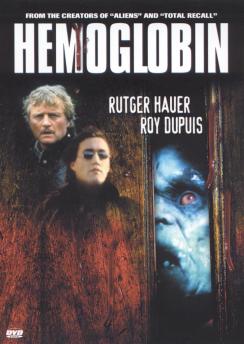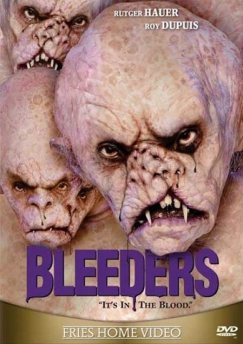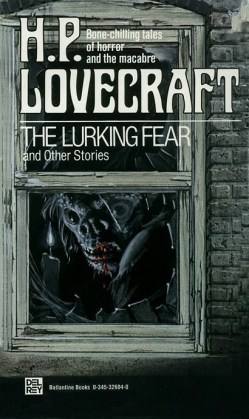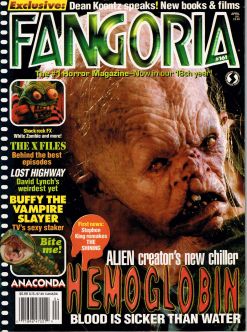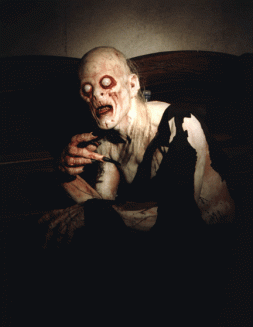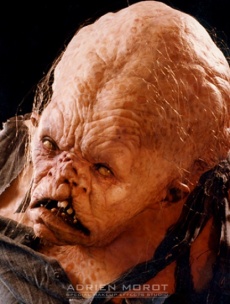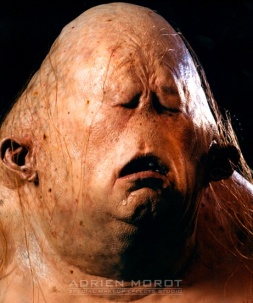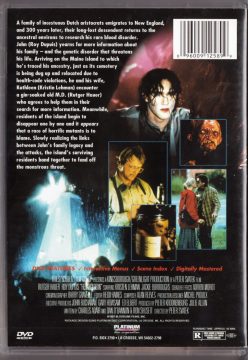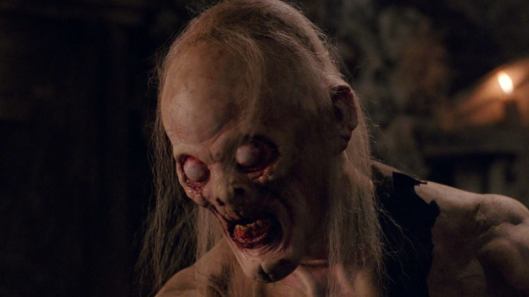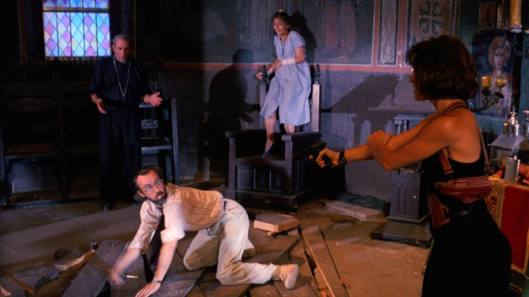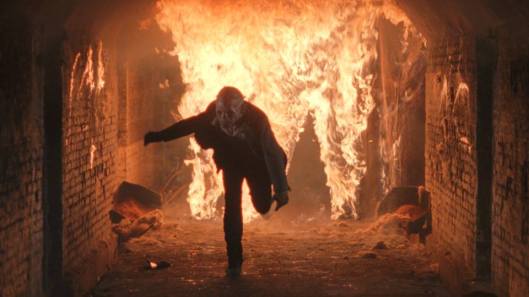“There was thunder in the air on the night I went to the deserted mansion atop Tempest Mountain to find the lurking fear . . .”
One of many Lovecraft tales I adore. I came upon it back in the summer of 1988 when I was still a teenager and still in the process of discovering the author. It was through the Del Rey paperback, The Lurking Fear And Other Stories, where I read it. The cover art by Michael Whelan also made a great impression on me. Back then that thing on the cover was what I always associated with this tale. I still do even.
Lovecraft’s tale of inbreeding and devolution starts way back in 1670 with a rich, antisocial chap by the name of Gerrit Martense who moves into the remote mountain region of Tempest Mountain to build his mansion. In the summer the area is routinely struck by violent thunderstorms, which I can only imagine can be quite a rollercoaster ride in extremely high elevations. These storms become somewhat of a (mental?) health hazard for Gerrit, described vaguely in the story as being “injurious to his head,” “Fitted up the cellar” is how the solution to these storms is described. So we can then assume when they struck he retreated to a “renovated” cellar of sorts that insulated him from the thunder.
The Martense line had in interesting genetic marker in the form of each family member having discolored eyes, one blue and one brown. Most of Gerrit’s family and descendants were reared to be just as antisocial as he and kept to themselves in that mansion. When contact with the outside world slowly dwindled . . .
they took to intermarrying with the numerous menial class about the estate. Many of the crowded family degenerated, moved across the valley, and merged with the mongrel population which was later to produce the pitiful squatters. The rest had stuck sullenly to their ancestral mansion, becoming more and more clannish and taciturn . . .
The Martenses managed at one point to give birth to a “normal,” and he was named Jan. This Jan managed to get away, get an education and even enter the army. Being in the army kept him away for six years, and when he returned he was viewed ironically as an outsider by his family and thus hated. He also didn’t acquire the “nervous responsiveness” to thunderstorms all Martenses seemed to have. During this time he had a pen pal who came looking for him when the letters stopped. This buddy was given the story that Jan was killed by lightening the Fall before and buried in the gardens on the property. This “excuse” didn’t settle well with Jan’s friend who came back a week later and dug in that garden where he found Jan’s skeleton with a bashed in skull.
The Martenses were charged with murder but without solid evidence no one was prosecuted. These charges ostracized the family from the rest of the world. No one would have anything to do with them, but they managed to eek out some kind of existence within those walls regardless. The family was left alone for 47-years. The only way the residents around the area knew they were still living was that every once in a while lights from the mansion could be seen.
The mountain locals are known as squatters and I get the feeling Tempest Mountain is a bit like Lovecraft’s town of Arkham, full of poor and the uneducated. Friendly, though, the ones in Tempest Mountain are said to be, unlike the residents of Arkham, if memory serves. Anyhow, some of these squatters in 1816 finally realized they hadn’t seen any signs of life in the mansion for a long, long time, so they went up to investigate and for an abandoned and in ruins home. Stories of it being haunted by the vengeful ghost of Jan Martense were part of its lore now. And that’s all that’s “publicly” known about this family.
Lovecraft’s tale is told from the first person. He describes himself as . . .
. . . that love of the grotesque and the terrible which has made my career a series of quests for strange horrors in literature and in life.
To translate that to modern 21st century terms nowadays this character would probably be labeled a paranormal investigator, but what has brought him to Tempest Mountain aside from the obvious lore?
Shiver . . . something terrible and bloody and mysterious has happened to an entire hamlet known as Leffert’s Corner recently. But there have been tales for eons about death that comes during the summer season. A demon, a devil, a something never fully seen that either snatches people off never to be seen again, or leaves them dead, like dismembered-gnawed-upon dead as described in the tale.
This particular summer when a thunderstorm hit the ground under a hamlet caved in after a lightening strike and 75 people were killed, 25 of them went missing. The 50 bodies present and accounted for were in an indescribable condition (see previous paragraph for description of said state).
The tale plays out as a mystery—who or what has been killing people over the decades on Tempest Mountain and who or what was responsible for this current massacre? The narrator and two of his long time friends, George Bennett and William Tobey, head up to the old Martense mansion to see if they can find out. Holing up in one of the master bedrooms, and armed, they intend to stay the night and see what happens. A storm strikes! The narrator is awoken by the sound of unholy shrieking as lightening and thunder reign down, and something was sleeping with him on the bed. An arm fell across his chest waking him and this thing’s shadow is cast upon the fireplace by the lightening as it gets up! The narrator is traumatized by what he sees! His two friends are never seen again and presumed to be the latest victims of this “lurking fear.”
The time frame of this tale begins in August of 1921 and ends in October. In that time, the narrator returns to his motel and recruits a new partner in his investigation, Arthur Munroe, but he doesn’t live long either. Every time a storm strikes someone dies and his death when I first read it was expertly penned. For weeks he and Monroe visit and revisit the mansion, and the hamlet where the massacre occurred, hoping to learn something, during one of these excursions a storm traps them in an abandoned shanty. Munroe takes it upon himself to look out the window to assess the storm while the narrator goes to the door as the storm suddenly dies down. But Munroe is still leaning out the window. Curious as to what has captured his attention, the narrator joins him at the window, puts a hand on his shoulder and when he turns the man around, Munroe is discovered to be dead—his entire face torn off!
There are pieces to this puzzle that are described and seen by our investigator the moment he enters Tempest Mountain, but are not linked to the “fear” until one night when he’s enjoying the moonlit landscape. Terrain all around the mountain is laced with these mounds, and on this very night it finally occurs to him all these mounds trail out from the Martense house, like tentacles! And there are portions of the woods that are unnaturally lush where the trees don’t look right.
At this point no one is thinking along the lines of underground monsters, in fact up until the investigator feels compelled to start digging in Jan’s ancient grave he’s half thinking it’s Jan’s ghost that’s doing it all, but he couldn’t be farther from the truth.
One of the joys of reading Lovecraft is when his characters are encountering the horror and how he’s able to expertly convey the texture and smells and the diggings it one’s sanity it makes . . . and the discovery of a tunnel under Jan’s grave, the tight exploration of it was unnerving to read. It’s all coming together now as a pair of red eyes and a claw are encountered in that claustrophobic and pitch black confine, while at the same time something else a mile away is trying to eat someone.
Dear Lord!! There’s more than one?!
Those mounds are how the monsters travel, and thunderstorms perturb them something awful, but what about those unnatural patches of trees? What must those roots really be feeding on?! It’s insinuated the blood and innards and remains of the people they eat and also of the creatures themselves, for they even feast on their own kind, since they’ve eaten the forest out of its entire natural fauna.
The one place never fully investigated is the cellar of the Martense house and in the final pages the narrator goes down there and finds a hole in the floor near the fireplace. There he waits, hidden on the other side of the room, gun in hand, for nightfall and the storms to come. And when it does here’s what he saw—
…God knows how many there were—there must have been thousands. To see the stream of them in that faint intermittent lightening was shocking. When they had thinned out enough to be glimpsed as single organisms, I saw that they were dwarfed, deformed hairy devils or apes—monstrous and diabolical caricatures of the monkey tribe . . .
After he shoots the last one and goes up to inspect it—
. . .The object was nauseous: a filthy whitish gorilla thing with sharp yellow fangs and matted hair . . .
The twist in those final scenes is that the dying creature had two discolored eyes, one brown and one blue, indicating the truth of what really became of the Martense family.
To date there are three movie adaptations of this tale: two unofficial, Dark Heritage (1989) and Hemoglobin (1997, aka Bleeders), and one “official,” if you want to call it that, from Full Moon Entertainment aptly titled, The Lurking Fear (1994). I’ve never seen Dark Heritage so I cannot comment on that one. Fangoria covered both The Lurking Fear and Hemoglobin in issues #135 (Aug 1994) and #161 (April 1997) respectively and as you can see the monsters from both movies made the covers.
Neither movie is especially faithful to Lovecraft’s short story, but I will say the “official” adaptation at least uses names and locations from the story. Both movies are equal, however, when it comes to each having an iconic genre actor in it’s cast (Jeffrey Combs in Lurking Fear, Rutger Hauer in Hemoglobin; both coincidentally play doctors) as well as having memorable and effective executed FX for their monsters. In fact Full Moon’s adaptation has two iconic horror actors, Ashley Lawrence (Kirsty from Hellraiser and Hellbound: Hellrasier II) takes the leading role.
Above is FX artist’s Wayne Toth’s creature and below is FX artist Adrien Morot’s creations for Hemoglobin. I will admit the creatures in Hemoglobin are not frightening, nor are they filmed to be frightening. What I do remember about Charles Band’s version and is evident from the photos above is that his creatures were more creepy and menacing looking. The things in Hemoglobin are legless and do fit the “dwarf” description from the story, and the things in Band’s version meet the “whitish” description but neither are ape-like. Yet, in the end, both do give off a general “Lovecraftian” vibe, which I absolutely love.
But before I review Full Moon’s “official” version let’s delve into Hemoglobin first. The movie takes place on a small island off the coast of New England. The prominent but now supposedly extinct family of the Van Daams settled it 300-years prior, but a great fire 75-years ago killed off the last of these anti-social outcasts. Supposedly. Then a John Strauss (Roy Dupuis) and his wife, Kathleen (Kristin Lehman), arrive from Paris in search of his family lineage. John has a congenital blood disease that give him routine seizures, bloody noses and a hunger for food he cannot identify, and if not cured or at very least treated better than his wife/nurse can do for him, he’ll die. He’s traced his “Strauss” family line here, but no one has ever heard of a Strauss on the island.
Rutger Hauer plays Dr. Marlow who’s only been on the island for two months and still nursing psychological wounds from the termination of his clinic in Johannesburg, Africa with alcohol.
John and Kathleen end up staying at a Hotel/Funeral Parlor (nice touch) run by the Gordon family. Bryde (Joanna Noyes) is the “alpha male” and not a very nice one. Husband/Father, Hank (John Dunn-Hill) and daughter, Alice (Janine Theriault), are the congenial ones.
John and Kathlees couldn’t have come at a worst time. The health department is investigating the Gordon’s funeral operations for shoddy work on the coffins. This results in the local graveyard being dug up so they can all be replaced, but what they find are the bottoms of most of them “broken into.”
In the meantime, John and Kathleen bounce between seeing Marlow and following leads that John may be a Van Daam. All they need to do to verify this is talk to the old, retired nurse, Lexie Krongo (Jackie Burroughs), of the former doctor on the island, who’s living at the old Van Daam estate on top of the hill. She indeed verifies this connection. All the Van Daams have those two colored (one blue, one brown) eyes but John was born after the fire which means the family still lives. He was sent away because he was different, normal, but Lexi always knew he’d would come back, probably because of his “blood disease.” It looks like John is our Jan Martense counterpart. And what he craves is embalmed human flesh. You see that’s what the deformed and inbred Van Daams have been feeding on thanks to the shoddy construction of Byrde’s coffins, but now that they’ve all been dug up the Van Daam’s are starving and the next best food supply are the human females on the island. I say females because this whole movies takes place over the entire time period the men are out fishing, which I gather can be days or weeks, and a storm in the final act delays their return while also cutting the island off from communication with the main land. It’s up to Marlow now to get everyone into the lighthouse and make a stand there while the Van Daams lay siege to the place.
Be warned this movie isn’t shy about killing off a child or two. Two are actually iced. A girl playing hide and seek in the dug up cemetery, who’s pulled underground and one of the boys she was playing with gets his in the final act. A tunnel under a recently buried islander is discovered, and that’s because Bryde had to bury this one in the Van Daam cemetery. Marlow takes it upon himself to go down and investigate but finds a horror show instead. During the course of the movie Brydie and her daughter, Alice, were taken by the creatures, and he finds their bodies hanging upside down, hands and arms mutilated from being gnawed on. His objective though was Romana, the little girl, and he does find her, but with a creature eating her corpse. The boy dies at the end when the floor gives way in the lighthouse and one of the creatures drags him off. John, who by then has already eaten a Van Daam fetus Marlow gave him when he finally understood what it is he was craving appears carrying the kid with the crawling inbreds at his feet. You actually think he’s saved the boy from the creatures, but he hasn’t, the boy is already dead. He kneels down with the kid, and slashes the kid’s wrist and takes a drink of his blood while the others join in. It’s not a gory scene at all, all of it is insinuated and you never see the slashing.
By now you’ve probably guessed Hemoglobin does not have a happy ending for John and Kathleen. Well, it does for John, for he reunites with his inbred family and the twin sister he never knew he had, so they can probably spawn and crank out more deformed cannibalistic underground dwellers. Kathleen was pregnant and it’s unclear what happens to her. There’s a short epilogue that takes place the next day with the men coming back. She mentions to Marlow she felt the baby kick and Marlow takes her by the arm and off they go. Off where, I don’t know. Did she stay on the island? No idea. I had the impression she wanted to leave for good, but it’s one of those question mark endings.
The gore and effects are very well done, and the gore isn’t especially strong either. Aside from the aforementioned gnawed on corpses there’s an autopsy of one of the creatures which is fairly sanguine and meaty.
Here’s an excerpt from an interview with the late writer/director, Dan O’Bannon, who himself contributed a very memorable entry to Lovecraft cinema with The Resurrected (1991), an adaption of The Case Of Charles Dexter Ward about his screenplay for Hemoglobin. You can find this interview in the book The Lurker In The Lobby: A Guide To The Cinema Of H.P. Lovecraft:
O’Bannon: . . .The other picture, Hemoglobin, I had some involvement with. It was an adaptation of “The Lurking Fear.” I heard it was filmed recently and didn’t get a release. Apparently it was horrible . . .”
Lurker: Did you do the script on your own or were you called in?
O’Bannon: Charles Adair brought that thing himself on spec for me to look at. It had several good scenes surrounded by chaos. What it needed was a rewrite to give it a nice, firm structure to carry those scenes. So I volunteered to help him, and the deal was I would come on as a co-writer and get some cut if anything happened. We finished the script… it had real possibilities. They went off to film it and a few years later I heard that it stank. Too bad.
Peter Svatek directed and the only two movies he did that come to mind are Witchboard III: The Possession (1995) and the Roddy Piper scifier, Sci-Fighters (1996). I can’t stand the Witchboard sequels, but I did like Sci-Fighters.
When the movie finally hit VHS and then DVD it did so under the title Bleeders. Simitar was the first company to put it on DVD in 1998. In 2006 it got re-released by Fries Home Video/Allumination FilmWorks, but sometime in 2004 apparently Echo Bridge Entertainment got a hold of it and put it out under it’s original title of Hemoglobin. I came upon it one year by accident on Amazon and ordered it on the spot. I used to have the Bleeders version but got rid of it, but seeing a release with the original title made it more attractive again. According to IMDB the Bleeders version is cut of all the nudity in the sex scene Dupuis and Lehman have in the final act, so I recommend getting the Hemoglobin version. And yet the run time on the Fries Home Video/Allumination version is 95-minutes. The Hemoglobin cut runs 90. Amazon is off by a minute. IMDB states Greece got a 94-minute version. Both versions are out of print, but used ones are still in the affordable range, especially for the Hemoglobin one. You can also buy a digital version from Amazon under the title The Descendant.
VIDEO/AUDIO/SUBTITLES: 1.33:1 full frame—Dolby Digital Stereo—No subtitles
Picture and audio are very good. According to DVD Exotica there’s a Japanese 2.35:1 widescreen laserdisc version in existence. Damn. Well we can only hope that some day a boutique label like Scream Factory, Synapse Films or some future one that hasn’t even formed yet decides it’s worth putting out in it’s original aspect ratio. The movie does have some really nice scenic shots that probably look spectacular in widescreen.
EXTRAS INCLUDED . . .
- Trivia Quiz
- Trailer
I’ve always preferred Hemoglobin to Lurking Fear. Having said that I haven’t seen Fear since it debuted on cable back in the mid-90s. I remember being excited that Lovecraft’s story was finally getting the movie treatment, but came away seriously disappointed after seeing it, for there was very, very little ported over. The best parts of the tale can be seen in the movie’s poster (upper left) (the tunnels branching out from the Martense home), and in the film as the Martense family name and the name of the town being besieged by the devolved Martenses, Lefferts Corners, are carried over. But that’s pretty much all that was carried over.
The movie focuses on the son of one of the Martenses, Jan, the normal Martense, who managed to get away for a while. In this version he had a son named, John (Blake Baily), who has just finished doing a 5-year prison sentence. He pays a visit to a local mortician, Skelton Knaggs (Vincent Schiavelli), who tells Martense he and his father robbed a bank many years ago and stashed the money inside a corpse to be dug up later. It was done for John, so he could set his life straight. Knaggs tells Martense where it is in Leffert’s Corners (this film version’s spelling) and that he’ll join him later that night. Unfortunately, the other members of that gang, Bennet (Jon Finch), Ms. Marlow (Alison Mackie) and Pierce (Joe Leavengood), that helped rob that bank just coincidentally decide to go looking for the money too. After getting the info from Knaggs and killing him off they go to Leffert’s Corner.
Outside of these criminals the movie also focuses on the few remaining survivors of the town, which has been plagued with the devolved Martenses for more than two decades. The movie never explains the particulars between the devolved Martense family and the human looking father and son. Do they start out being born human looking and then become monstrous as they grow older, or what? A plausible scenario since that’s how the townsfolk of Innsmouth metamorphosis in Lovecraft’s novella ‘The Shadow Over Innsmouth.‘
The movie starts out introducing sisters, Leigh (Llinca Goia) and Cathryn Farrell (Ashley Laurence being billed here for some unknown reason as Ashley Lauren). Leigh doesn’t make it out of the prologue as she’s gutted and pulled into the wall of her house by a devolved Martense. Cathryn’s motive now becomes kill every monstrous Martense in existence, so she goes off, becomes all Linda Hamilton from Terminator 2, teams up with the local physician, Dr. Haggis (Jeffery Combs sporting longer than normal hair and a beard) and concocts this master plan of booby trapping the local cemetery with trip wire and dynamite and holing up in the church. You see the Martenses live under the ground under the church, with tunnels going everywhere under the cemetery. It’s a shame Cathryn (Katherine was also the name of Barbara Crampton’s character in the H.P. Lovecraft adaptation From Beyond that Combs was also in) chose this night to pop the top on her can of terminal whoop-ass, because soon John shows up, followed soon by Bennet and his “gang” all eager to get that money.
Interesting to note Comb’s Dr. Haggis character is a lush, much like Rutger Hauer’s Dr. Marlow from Hemoglobin. These two characters also reminded me of the local small town physician in Ray Russell’s horror novel, Incubus. That character too had a drinking problem. As usual Haggis doesn’t make it out of the movie alive, though he manages to keep himself out of harm’s way for a good chunk of the movie. There are a few ancillary characters like Father Poole (Paul Mantee), Maria (Cristina Stoica), Beth (Luana Stoica) and Ryan (Adrian Pintea), town locals who also hole up in the church along with the main cast, but they don’t add much to the story other than being victims for the creatures or for Bennet’s gang. One nice touch I liked, though, was a couple of the creature’s survivor’s (locals) sported hideous claw wounds on their bodies, mostly on their faces, to give you some sense of the daily struggle the townsfolk have gone through. One woman had her eye taken out. That was hideous to see. No pun intended. Another, a man, had similar wounds on the side of his face, but thankfully his eyes were intact.
The monster(s) appear throughout the movie from time to time, until we finally get a bunch of them in one shot in the final act, until then you only get only one creature in any given scene. Director C, Courtney Joyner’s version is not plotted out as a mystery as Lovecraft’s original tale was. We already see the creatures, know they exist, and know they’ve been eating their way through the town for decades. Another main difference is the “main” creature is able to speak, giving us clear indications these versions aren’t as devolved as the ones in Lovecraft’s story. Some of them are seen still wearing clothing.
The movie ends when Cathryn finally gets her wish and blows the fuck out of the Church, the cemetery and parts of the town as she dumps huge amounts of fuel into their lair via a tanker truck.
I found out last night I don’t hate The Lurking Fear as much as I used to. When you’re re-evaluating a movie (especially one you haven’t seen for decades), it helps to have that re-evaluation occur under circumstances that involve a remaster. Of all the Full Moon blues I’ve reviewed this is the best looking one I’ve seen! Seeing it widescreen for the first time really gives you a better appreciation of the Romanian landscape and buildings it was shot in, and the blood is very distinctly red too.
If you can divorce yourself from the fact it’s supposed to be based on a Lovecraft tale (very loosely based), it’s really not a bad movie, and that’s how I looked at it this time. Besides when’s the last time you saw “Herbert West” and “Kirsty Cotton” in a movie together?
VIDEO/AUDIO/SUBTITLES: 1080p 1.78:1—2.0 English Dolby Digital Stereo, 5.1 English Dolby Digital Surround—no subtitles
EXTRAS INCLUDED . . .
- Audio Commentary With Director C. Courtney Joyner
- Videozone (6:40)
- Deleted Scenes Reel (4:10)
- Full Moon Trailers
Always loved the Full Moon Videozone extras. Here you get on the set footage and interviews with Combs, Mackie (turns out she’s the director’s cousin), Laurence and Bailey. The Deleted Scenes have no audio. Apparently they couldn’t find it, which is too bad, I saw at least two scenes that could’ve been restored, one of them being an epilogue with Bailey and Laurence’s characters settling down and having a kid, but appearing to end on a sinister note.
You can buy The Lurking Fear on Full Moon’s site and on Amazon!

